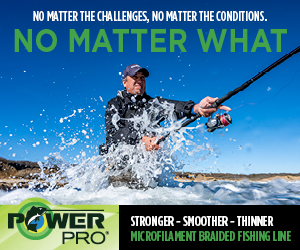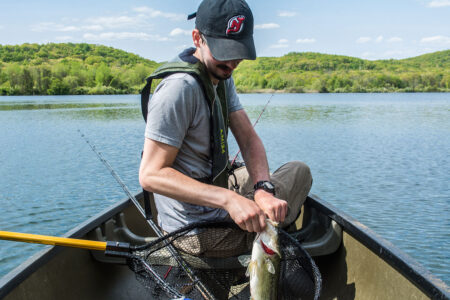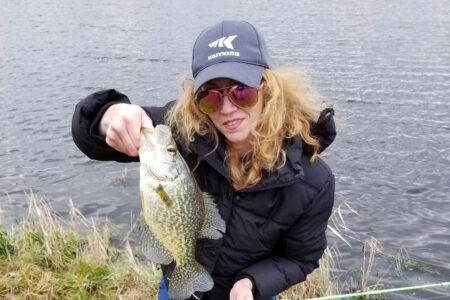
“The depths serve as a comfortable place for bass to slip back to. Especially with a meal!”
For many years, we caught largemouth bass in very shallow water in a spot occupied only 4 or 5 square feet on top of a point, which dropped quickly into 35-foot depths. One would wonder why it produced. My son caught them, friends did, and I expect to catch more yet. Walleye in October depths have been our main target, but the size of one bass rivaled them. I took the clue and recognized a pattern to play out.
Not only have other points of other lakes amounted to that pattern, I don’t limit my interest to the fall season. During an afternoon last June, Kevin Murphy and I decided to quit trolling and work a long shoreline by casting Senkos. When we came to a right-angle turn into the shallows of a large point, I shot a cast directly in front of the bank. My line moved quickly in the direction of deep water, so I took up slack, and I set the hook into a nice smallmouth bass. Kevin netted the fish. I pushed aside the handle of the stern-mounted electric motor as I gave the prop juice, getting us out in front.
That happened after smallmouths left the spawning beds. It’s not surprising, though, that the bass struck in a foot of water, partly because 35-foot depths are also near this spot. Baitfish down there easily disperse when bass attack. Any that might instead be in the shallows, including sunfish and juvenile bass, are by comparison easily cornered and devoured. The depths serve as a comfortable place for bass to slip back to. Especially with a meal!
During the summer months of July and August, smallmouths don’t necessarily abandon shallows. Even in lakes with plenty of oxygen in depths of 50 feet or greater, smallmouths will frequent very shallow water early in the morning. It helps to present a lure you can cast a country mile. A Senko is perfect, but so is a topwater plug, particularly if you can lay it down easily instead of making a big splash.
On a late July morning before sunup, I put a 3/8-ounce Rebel Pop-R 6 or 7 feet in front of a small point, more like a tongue of gravel and sand. Most of the shoreline we worked dropped off sharply to 10 feet and on down to about 30. The tongue proved to be an exception. I could tell, because the moment the plug touched down, a wake proceeded forward from right against the top of that point. Obviously, the water was so shallow it barely covered the back of what I thought was a pickerel. The V-formation ceased upon the fish’s engulfing the plug, a fish that proved to be a smallmouth just shy of 19 inches.
Apparently, the point had formed as the result of runoff from a trail coming down a sloping bank, the sand and gravel piling up in the water. A point of land doesn’t need to be large to hold fish, but virtually all points have shallows, most have middle-range depths, and many reach into very deep water. I like the ones that go deep, because that assures me of large bass following them up into shallows.
If, however, you’ve never caught bass deep, I suggest you try fishing the depths until you do. I believe in fluency when it comes to catching bass wherever they will be in a lake or whole set of lakes. If you can catch bass deep, you can become adept at catching them shallow. Vice versa is also true, though it’s all too easy to get stuck in the habit of catching them in shallow cover and along shorelines.
Do fish the top of a point first. If you work your way up to the shallows, you’ll probably have spooked any shallow-water bass by lingering nearby. Don’t hesitate to work your way down from the shallows, a process an unweighted Senko is good for to about 20 feet deep. You’ll become familiar with differing depths by catching bass from them. The same goes for different lures. Any lure suddenly becomes a confidence trick once you’ve caught a fish on it. Likewise, you might have been led to believe only the depths of a point produce. Catch bass in the shallows instead, and you’re on the way to having the whole structure in command.




